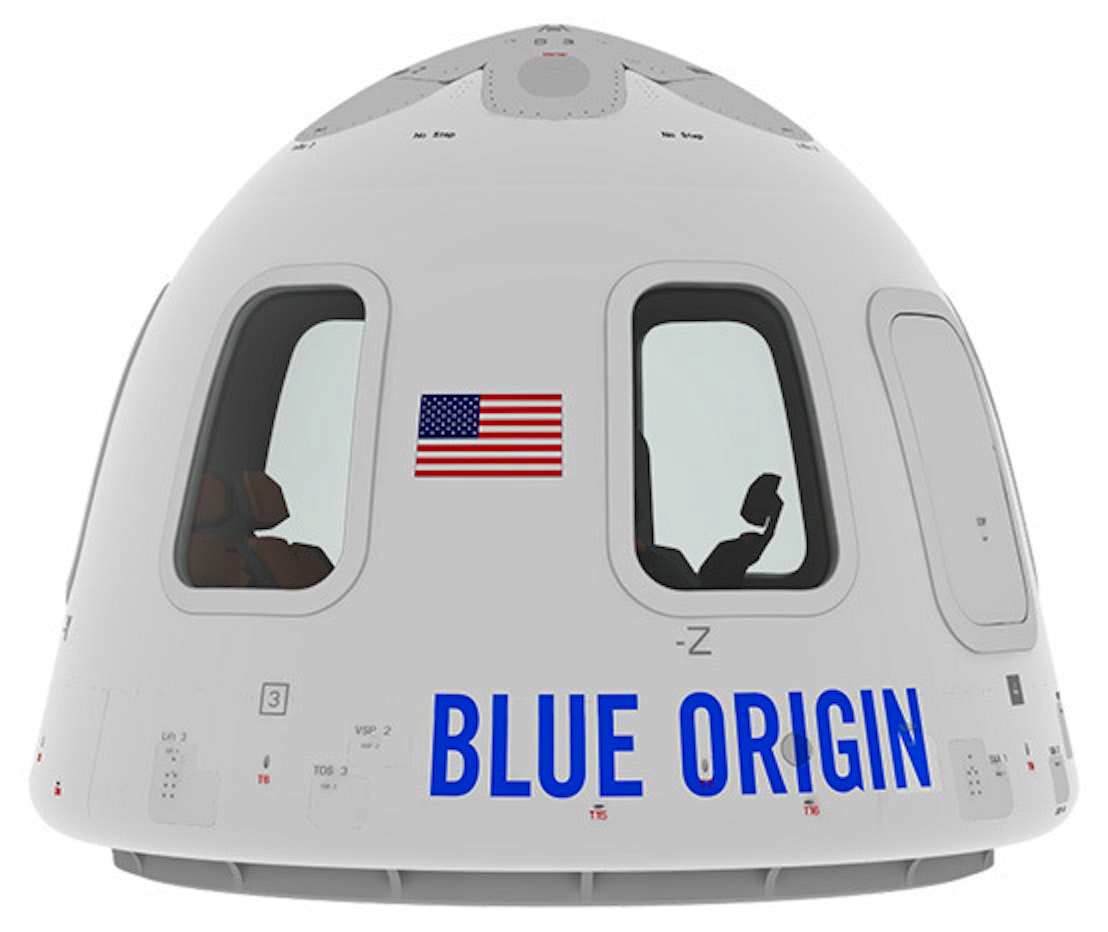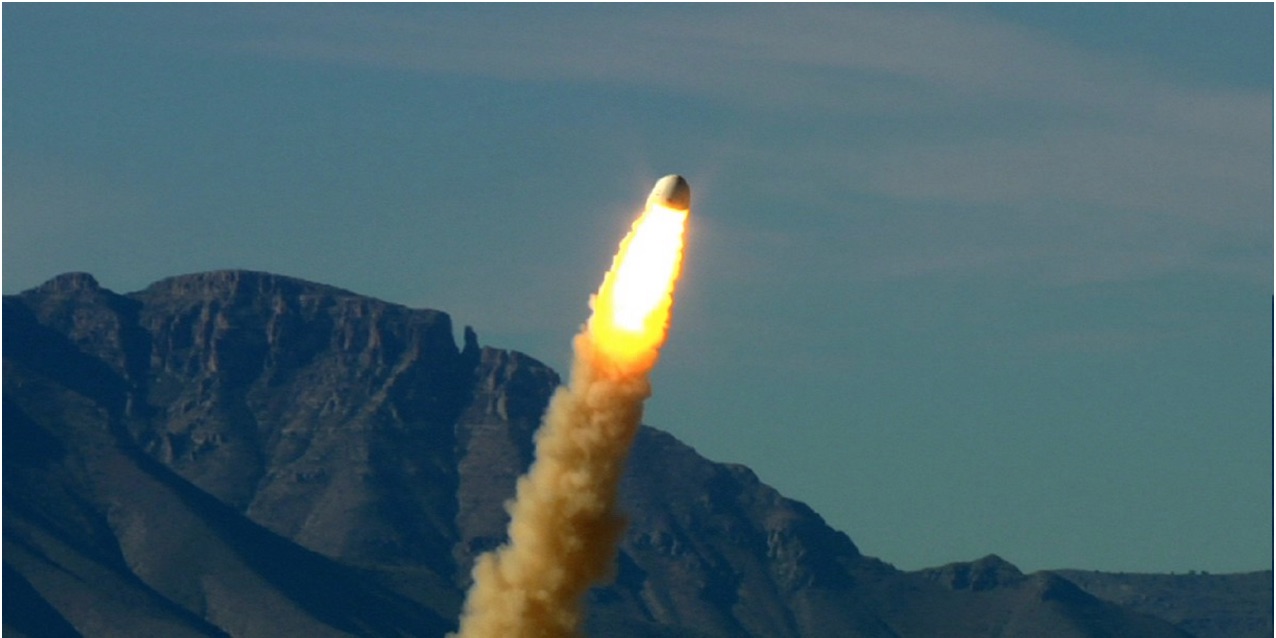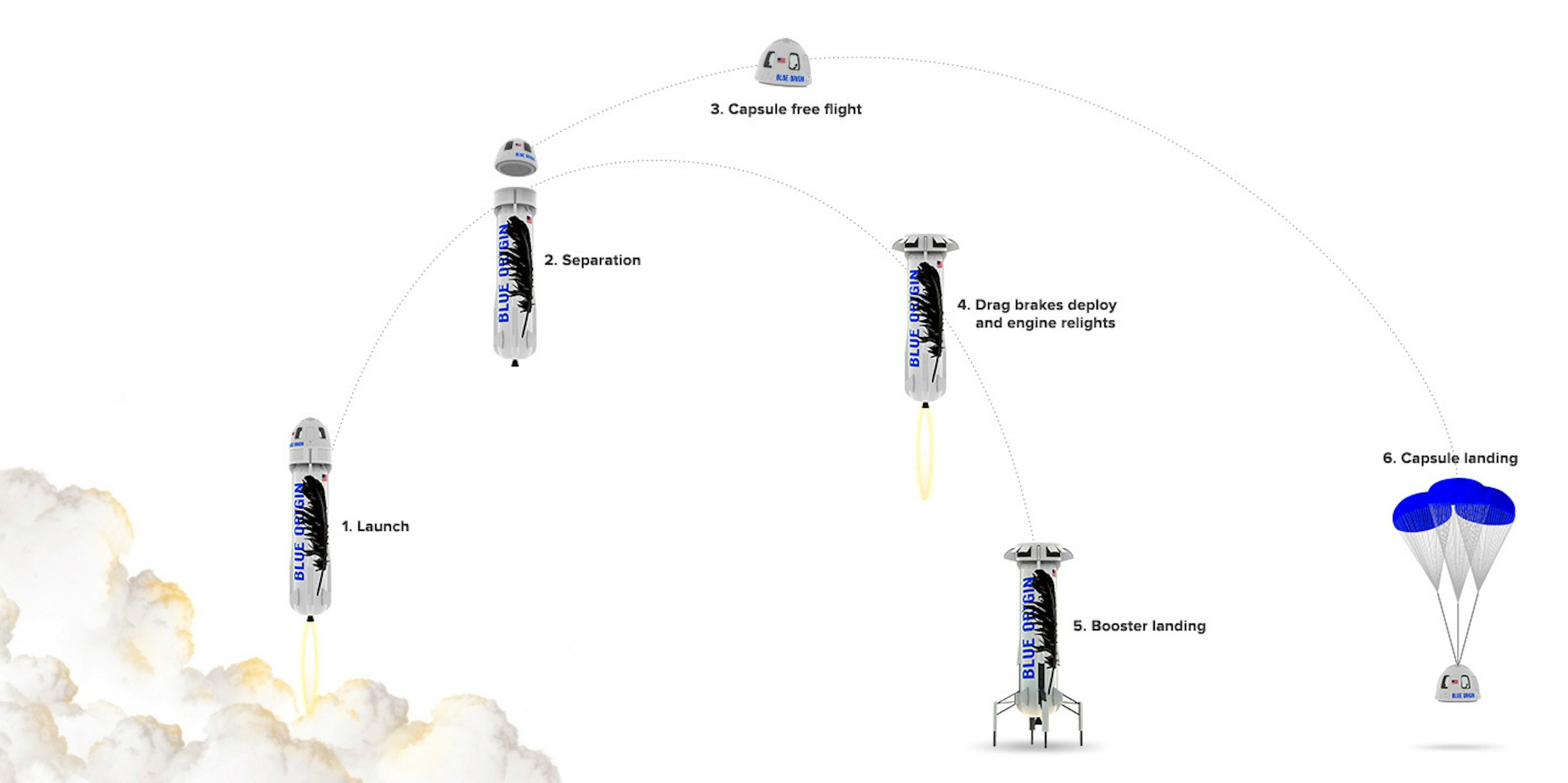
Amazon billionaire Jeff Bezos’ Blue Origin space venture is aiming to conduct its toughest flight test to date on Tuesday, Oct. 4, an auspicious date in space history.
Blue Origin’s New Shepard suborbital spaceship will blast off from the company’s test range in West Texas on Tuesday morning, the company said today in a tweet. It’s due to be webcast via Blue Origin’s website.
This New Shepard has made four successful uncrewed flights to space and back over the past year, but it’s not likely to survive next week’s go-round intact.
The crew capsule (which doesn’t carry any crew for these tests) will be programmed to light up its solid-rocket escape system about 45 seconds after liftoff, at an altitude of 16,000 feet, when the aerodynamic stresses on the craft are at their peak.
Simulations suggest that the firing will deliver a heavy blow to the booster rocket below, most likely breaking it apart. The capsule, meanwhile, should zoom out of harm’s way and descend back to the range safely at the end of its parachutes.
The test is meant to verify that the escape system will work properly if it’s needed during a future flight with passengers aboard.
There’s a slight chance that the booster will stay in one piece and make a safe vertical landing, as it has in the past. In any case, the capsule and whatever’s left of the booster will be retired to a museum or museums to be named later.
Oct. 4 is a big day in space history for a couple of reasons: On that date in 1957, the Soviet Union put Sputnik into orbit, ushering in the classic Space Age and the U.S.-Soviet space race. In 2004, the SpaceShipOne rocket plane won the $10 million Ansari X Prize, marking a milestone in the commercial space race.
Today, Bezos’ Blue Origin ranks among the leaders in commercial spaceflight, along with SpaceX and Virgin Galactic.
Quelle: GeekWire
---
Blue Origin to test New Shepard abort system next week

GUADALAJARA, Mexico — Blue Origin plans to test the abort system on its suborbital New Shepard vehicle on Oct. 4 as the company trickles out additional details about its New Glenn orbital launch vehicle.
The company announced Sept. 29 that the test, which the company said earlier this month would take place in early October, is now scheduled for Oct. 4 from the company’s test site in West Texas. The company did not release a launch time, but said a webcast of the event would begin at 10:50 a.m. Eastern.
The liftoff will be similar to several previous New Shepard test flights, but 45 seconds into the flight the abort motor in the crew capsule of the vehicle will fire, sending it away from the propulsion module. The crew capsule will then parachute to a landing similar to that on a normal flight, when the crew capsule separates after main engine burnout.
Blue Origin warned, though, that the propulsion module is not likely to survive the abort test. “The booster was never designed to survive an in-flight escape,” Bezos wrote in a Sept. 8 message discussing the upcoming test, citing “70,000 pounds of off-axis force delivered by searing hot exhaust” slamming into the module from the crew capsule’s escape motor.
Bezos, though, did not rule out being able to land the module safely, saying there’s “some chance” it will be able to survive the aerodynamic forces from the abort event and land safely. “If the booster does manage to survive this flight — its fifth — we will in fact reward it for its service with a retirement party and put it in a museum,” he wrote.
The announcement of the New Shepard test comes days after the company offered a bit more information about the New Glenn vehicle that Bezos announced Sept. 12. Bezos, in a pair of tweets Sept. 26, said that Blue Origin had completed three weeks of wind tunnel tests of a model of the large orbital launch vehicle. One photo showed a module of the full rocket, and another of the “descent configuration” of the first stage as it returns for a landing.
The tests, Bezos said, studied the performance of the rocket at transonic and supersonic speeds. “Validated our CFD,” he wrote, referring to computational fluid dynamics modeling of the rocket.
The company has yet to release many details about New Glenn beyond its physical size and number of engines. The first stage uses seven BE-4 engines that Blue Origin is currently developing, and the second stage has one BE-4. An optional third stage uses a BE-3 engine based on the one used by New Shepard.
In an interview during the International Astronautical Congress (IAC) here Sept. 27, Blue Origin President Rob Meyerson said that the company will provide more details about New Glenn in the coming months. “The beginning of next year is when we hope to release more information about New Glenn,” he said.
The timing of the wind tunnel tests announce came the same day that SpaceX Chief Executive Elon Musk announced a successful test of his company’s new Raptor engine. It was also a day before Musk’s major announcement of his Mars mission architecture at the IAC.
Meyerson said the announcement of the wind tunnel testing was not meant to “one-up” SpaceX. “This is not what we think about when we put out an announcement,” he said. “For the wind tunnel tests, three weeks of testing were completed. It’s significant and tied to the New Glenn announcement from the 12th, so it went out.”
He also sought to downplay any competition between Blue Origin’s and SpaceX’s launch vehicles, arguing that a future with an expanded human presence in space requires multiple providers. “We really believe in the success of all the other launch companies,” he said. “We’re going to need that to enable that future.”
Quelle: SN
-
Update: 2.10.2016
-
Watch Blue Origin's In-flight Escape System Test on October 4
Blue Origin, the West Texas-based spacecraft company founded by Jeff Bezos, is planning to test a crew escape system for its New Shepard rocket this Tuesday, October 4 at 10:50 a.m. Eastern. The test will be live-streamed, and will give space enthusiasts and astronauts alike an opportunity to observe how the rocket responds in high-stress conditions.
Although the New Shepard has already had four successful launches since November 2015, the test is a precaution to guarantee absolute safety for its potential passengers. The New Shepard’s escape system is built differently from Bezos’s other rockets. The escape motor in the New Shepard is located on top of the capsule, therefore causing the motor to push the capsule away from a failing booster.

During the test, the mission control team will trigger an escape alarm while the airflow is supersonic — or faster than the speed of sound. The escape launch will take place once the rocket is at 16,000 feet, approximately 45 seconds after liftoff. During the escape procedure, the motor fires for two seconds, propelling the crew capsule to thrust away from the booster. Once the capsule is separated, it makes its descent back to Earth armed with reaction control thrusters and parachutes, enabling a swift and steady coast.
Since the company’s success of their last crew escape test on October 19, 2012, next week’s test should bode well for Blue Origin. Although back then, the test only involved firing the crew capsule from the launch pad. This test is more advanced, as the capsule is attached to a booster.
Despite the excitement around the launch, Bezos is a little behind the times. Elon Musk’s SpaceX already had their escape capsule test launch for Crew Dragon back in May 2015. SpaceX’s escape system for Crew Dragon is vastly different than New Shepard’s. Crew Dragon’s capsule is located on the side of the engine rather than on top. The four engines, known as SuperDracos that were produced from 3D printers, create 120,000 pounds of thrust, taking the spacecraft from 0 to 100 mph in 1.2 seconds to push away the capsule.
Since the booster isn’t designed to survive the mission, Bezos plans to retire it and put it on display in a museum after the test.
“Our next flight is going to be dramatic, no matter how it ends,” said Bezos. That means mark your calendars for this Tuesday.
Quelle: INVERSE
-
Update: 4.10.2016
-
Blue Origin Delays Rocket 'Escape Test' to Wednesday Due to Bad Weather

Blue Origin has delayed the highly anticipated "in-flight escape test" of its New Shepard suborbital spaceflight system by one day to Wednesday (Oct. 5), citing bad weather at its West Texas test site.
"Weather no-go for tomorrow’s New Shepard #InFlightEscape test. Webcast now Wednesday 10:45 am ET [1425 GMT]," Blue Origin announced today (Oct. 3) via its Twitter account, @blueorigin. (Space.com will carry Blue Origin's webcast of the test, if possible.)
New Shepard consists of a rocket and a capsule, both of which are reusable. During Wednesday's test, the capsule will fire its onboard escape motor for two seconds shortly after liftoff, jetting hundreds of feet away from the booster. The goal is to prove out the system — which would get astronauts out of harm's way in a real-life launch emergency — during flight.
Blue Origin is run by billionaire Amazon.com founder Jeff Bezos. The company is developing New Shepard to take people and payloads on brief flights to suborbital space, but its ambitions don't end there. Last month, Bezos announced that Blue Origin is also working on a big orbital rocket dubbed New Glenn. (New Shepard is named after Alan Shepard, the first American to reach space; New Glenn takes its name from John Glenn, the first American to orbit Earth.)
Quelle: SC

